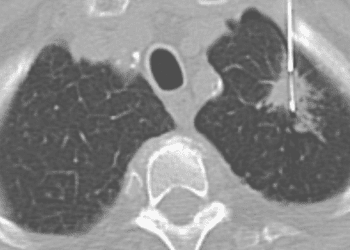Improved overall survival with HPV positive oropharyngeal squamous cell carcinoma
1. Compared to HPV negative oropharyngeal squamous cell carcinoma, HPV positive tumors are associated with increased overall survival after progression of disease.
Evidence Rating Level: 2 (Good)
Study Rundown: Certain strains of human papillomavirus (HPV) are associated with oropharyngeal squamous cell carcinomas (OPCs), and HPV positive tumors have significantly reduced risk of cancer progression compared to HPV negative tumors. At the conclusion of this retrospective analysis, the authors found that positive HPV status was significantly associated with increased overall survival following local, regional or distant disease progression. Positive HPV tumor status and receipt of salvage surgery were both associated with reduced mortality after progression. Similar rates of and distribution of distant metastases were noted in both groups. Based on these results, the authors suggested that HPV status represents a significant prognostic marker in the evaluation of progressive oropharyngeal squamous cell carcinoma. However, it should be noted that the authors were unable to evaluate the effect of chemotherapy on overall survival. Furthermore, the HPV positive and negative groups had distinct demographic characteristics.
Click to read the study in JCO
Relevant Reading: Human papillomavirus and survival of patients with oropharyngeal cancer.
In-Depth [retrospective cohort study]: The authors of this retrospective analysis drew patient data from several phase III prospective clinical trials evaluating different radiotherapies in the treatment of confirmed oropharyngeal squamous cell carcinoma. A total of 181 patients were included, with 105 HPV positive and 76 HPV negative, and all had experienced local, regional, or distant disease progression. Multivariable analysis included HPV status, T stage at enrollment, progression type, salvage surgery, and pack years. The primary outcome was overall survival after disease progression. HPV positive patients were significantly more likely to be younger, Caucasian, report less cumulative cigarette exposure, and present initially with earlier tumor stages. The median time to disease progression was similar between the two groups (8.2 versus 7.3 months; p = 0.67). The mean follow-up time after progression was first noted was 4 years. On Kaplan-Meier analysis, HPV positive patients had significantly increased overall survival following progression compared to HPV negative patients (HR 0.49; 95% CI, 0.34-0.70, p < 0.001). HPV positive status (HR 0.48; 95% CI, 0.31 to 0.74) and receipt of salvage surgery (HR 0.48; 95% CI; 0.27 to 0.84) were both associated with reduced mortality after disease progression.
Image: PD
©2012-2014 2minutemedicine.com. All rights reserved. No works may be reproduced without expressed written consent from 2minutemedicine.com. Disclaimer: We present factual information directly from peer reviewed medical journals. No post should be construed as medical advice and is not intended as such by the authors, editors, staff or by 2minutemedicine.com. PLEASE SEE A HEALTHCARE PROVIDER IN YOUR AREA IF YOU SEEK MEDICAL ADVICE OF ANY SORT.




![2 Minute Medicine: Pharma Roundup: Price Hikes, Breakthrough Approvals, Legal Showdowns, Biotech Expansion, and Europe’s Pricing Debate [May 12nd, 2025]](https://www.2minutemedicine.com/wp-content/uploads/2025/05/ChatGPT-Image-May-12-2025-at-10_22_23-AM-350x250.png)


